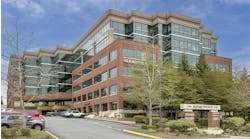Chicago — Willis Tower, formerly known as the Sears Tower and one of the most recognizable buildings that make up the Chicago city skyline, will soon undergo one of the largest sustainable modernization projects in the U.S., if not the world, which will include upgrades to the mechanical systems, restroom fixtures and condensation recovery systems, and testing renewable energy sources, likely resulting in U.S. Green Building LEED Platinum certification once completed.
Since 1989, the Willis Tower, which already meets LEED criteria, has reduced annual energy consumption by 34%, and since 1984, its energy efficiency improvements have resulted in a reduction of 51 million pounds of carbon emissions annually. Plus, water consumption in the building has been reduced by more than 10 million gallons per year over the past 20 years.
A main goal of the recently announced sustainable modernization project is to decrease energy consumption even more.
“Our goal in the Willis Tower greening project is to create a holistic approach that integrates high-performance building technologies and design strategies for maximum energy efficiency,” said Adrian Smith, partner of Chicago-based Adrian Smith + Gordon Gill Architecture. “In the process, we hope to set a benchmark for how high-rise buildings throughout the world can limit their impact on the environment.”
Sustainable strategies to reduce energy consumption, designed by AS+GG, involve mechanical system upgrades.
Co-generation gas boilers that utilize fuel cell technologies will replace the electric boilers. The co-generation boilers will generate electricity, heating and cooling at as much as 90% efficiency. Other mechanical upgrades include installing new high-efficiency chillers and improving the air distribution system.
“Cutting the consumption of electric by 80% includes saving 72 million pounds of carbon per year and reducing electrical consumption by 68 million kilowatts per year,” said John Huston, principal and vice president of American Landmark Properties, representing the partnership that owns the Willis Tower.
Another goal of the project is to decrease water consumption by upgrading the restroom fixtures, condensation recovery systems and water efficient landscaping. Water usage will decrease by 40% overall, and 24 million gallons of water per year will be saved, according to Huston.
On the roofs of the Willis Tower, renewable energy — wind and solar — will be tested. Wind turbines will be installed on the roofs and tested to take advantage of the tower's height and unique set-back roof areas, advancing the understanding of building-integrated wind power in existing structures.
“Wind currents in that area are very interesting and there is no extensive study on those winds,” said Huston. “The building was not designed to maximize the ability to use wind turbines, so we don't know which kind will work and which ones will work the best, so there will be experimentation with this.”
On the roof of the 90th floor, which is facing south, photovoltaic solar panels will be installed to generate energy.
“It is 90 floors above the ground, so it will be the highest photovoltaic field in the world that we know of,” said Huston. “Things will happen at that height, and there will be experimentation with this as well.”
The Willis Tower modernization project started as a window replace program a few years ago. Building owners wanted to replace all the windows in the building with double-pane insulated windows.
According to Huston, there was resistance to this at first, but by asking many questions and researching what windows could be installed, it was realized that insulated windows could be installed and that all systems within the building affect one another.
“We found out that the window system can't be separated from the curtain wall systems,” said Huston. “Once the curtain wall is replaced with a thermally broken and insulated curtain wall and windows are replaced with triple-glazed windows, then the capacity of the HVAC is substantially reduced and we can change things on the inside.”
Besides testing renewable energy sources and upgrading the mechanical systems, other modernization initiatives include improvements to the building's exterior envelope and windows, and upgrades to the lighting system, including advanced lighting control systems and daylight harvesting. Green roofs will also be tested to find out how they affect energy efficiency and mitigate the urban heat island effect.
The project will create approximately 3,600 green manufacturing and installation jobs. Mechanical contractors will bid on the Willis Tower modernization project in late 2009/early 2010.

